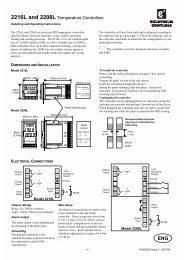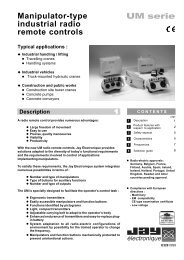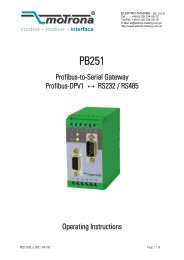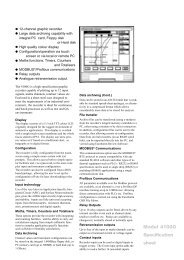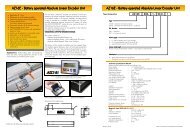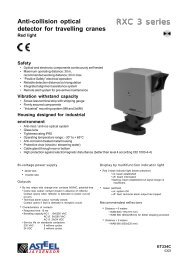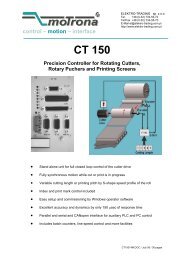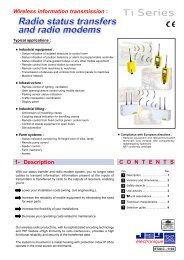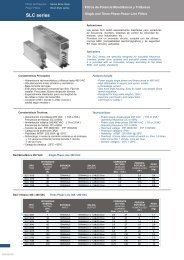PC3000 Complete Installation guide iss 12 - Elektro-Trading
PC3000 Complete Installation guide iss 12 - Elektro-Trading
PC3000 Complete Installation guide iss 12 - Elektro-Trading
Create successful ePaper yourself
Turn your PDF publications into a flip-book with our unique Google optimized e-Paper software.
General<br />
<strong>PC3000</strong> <strong>Installation</strong><br />
4 Channel Analogue Input Module<br />
The module to be calibrated should be installed in the <strong>PC3000</strong> rack and allowed at<br />
least 30 minutes of warm up time prior to calibration. It is recommended that the<br />
module be orientated vertically and the rack mounted flat (i.e not at an angle) if<br />
application permits. This will minimize the potential for temperature gradients across<br />
the module.<br />
The module should be located away from heat sources such as thyristor units and<br />
solid state relays. Draughts should also be avoided.<br />
The use of copper cable is recommended for all calibrations unless otherwise stated.<br />
Lead length should be minimized in order to reduce the effects of input bias current<br />
flowing back into the calibration input source (Approximately 250mA); if long leads<br />
are unavoidable, calibration accuracy may be improved by measuring the true<br />
applied voltage at the input terminals of the input module and using this value as the<br />
calibration reference rather than the value as set at source.<br />
Calibration overview<br />
The purpose of calibration is to eliminate or reduce inherent errors associated with<br />
the modules hardware. As an example, the voltage references used for the analog/<br />
digital converter have an initial tolerance; calibration serves to reduce or eliminate<br />
this error such that the measurand reflects the true value more closely. Additionally<br />
errors in calibration occur over time as electronic components age, requiring that<br />
routine calibration is carried out at regular intervals.<br />
It is not suggested that calibration is used as a means of correcting for errors associated<br />
with the sensor; this type of error should be eliminated by use of the prelinearisation<br />
scaler and offset parameters provided on the Analog_In Function Block.<br />
The PC 3000 analog input module employs a two point calibration scheme in order<br />
to correct for both gain and zero offset errors. The two arbitrary calibration points<br />
may be calibrated independently and the resultant calibration data stored. However,<br />
it is recommended that both points are calibrated during the same calibration<br />
session.<br />
Calibration is performed on the currently selected range and configuration e.g.<br />
50mV linear, 0 to 5V etc. Each range/configuration has separate calibration data<br />
associated with it. All ranges/configurations are calibrated when the module is<br />
despatched from the factory.<br />
Calibration data is stored in EEPROM in the input module.<br />
A channel requiring calibration due to corrupted data or a ‘raw’ channel which has<br />
no calibration data will declare the state No_Cal ( 4) via the Analog_In function<br />
block parameter, Status_Info.<br />
9-11



